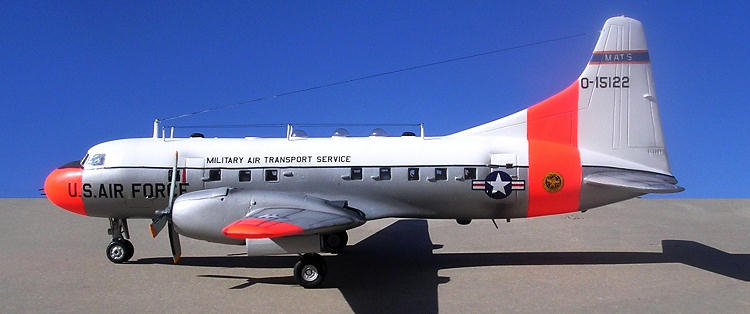
Execuform 1/72 T-29D
| KIT #: | ? |
| PRICE: | $25.00 |
| DECALS: | No options |
| REVIEWER: | Carmel J. Attard |
| NOTES: | Vacuform with metal and resin parts |

| HISTORY |
Convair built a total of 508 military versions of its 204/340/440 commercial
transport series for the USAF and USN. First military model was the T-29A, an
unpressurized navigation, and bombardment and radar trainer. The first flight
took place on 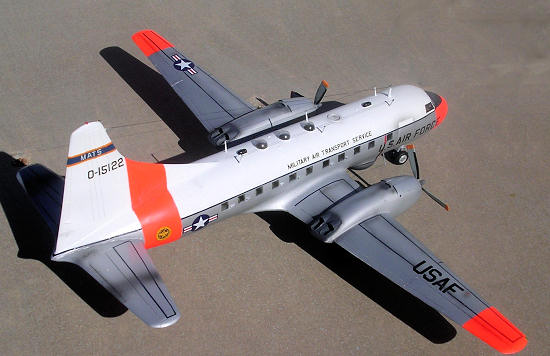
Conversion for staff transport use serve as the VT-29A, B, C and D. C-131A
Samaritans (26 built) were air evacuation transports based on the Convair 240;
some became VC-131As with plush interiors. The C-131B 48 –seat transport/
electronic test-bed (36 built) and C-131D transport (33 built) were based on
model 340, as were the two YC-131C turboprop test beds. Ten C-131Es were built
as electronic countermeasure trainers, but six were converted subsequently into
RC-131F photo-survey and charting aircraft and one to RC-131G standard for
checking airways aids for M.A.T.S. The Navy received 36 C-131F cargo, personnel
and evacuation transport, and two C-131G (Model 440) transport/research
aircraft; it also operated about 10 T-29Bs transferred from the U.S.A.F. Four
VC-131Hs were re-engined with Allison 501D-13 turboprops for
| THE KIT |
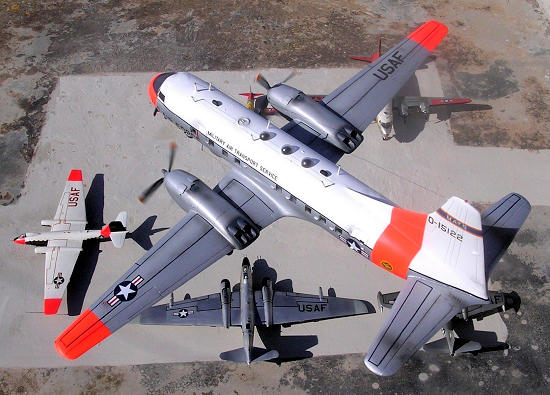 a
T-29 (which was my case) the side view shows the Radome shape but this alone was
insufficient and a plan view from the underside or at least a scrap front view
of the radome area would have been very helpful. To my surprise there was no
acetate part for the radome. I had to study a number of photos of the T-29
showing the belly radome taken from different angles so that I could make my own
drawing for the item.
a
T-29 (which was my case) the side view shows the Radome shape but this alone was
insufficient and a plan view from the underside or at least a scrap front view
of the radome area would have been very helpful. To my surprise there was no
acetate part for the radome. I had to study a number of photos of the T-29
showing the belly radome taken from different angles so that I could make my own
drawing for the item.
Among the instructions are
drawings to make internal stiffening parts such as cabin bulkheads, fuselage
stub parts, wing spars and cabin floor. A template drawing to help marking the
fuselage rectangular windows is also provided. I noticed that there were many
variations between one T-29 and another and this is besides the changes that
occur on a particular aircraft during its lifetime in form of external detail
and color scheme. My
plan was to study the book: “T-29 Flying Classroom (Naval Fighters series No
14)” by Steve Ginter which I had and also other material on internet and my
fancy fell on T-29B serial number 0-015122. This was a navigational trainer in
Military Air Transport Service livery. The kit has optional parts or drawings to
make other derivatives of the Convair including those with ‘Pug’ nose radome
retrofitted to many 240 series E.g. USCG type, as well as variations in the
exhaust area and different engines of some other types like series 300.
| CONSTRUCTION |
As from an early stage one
need to decide which of all the derivatives of Convair one opts to build. In my
case my priority falls on a colorscheme particularly if it fitted one I have
spotted at some time flying in Maltese skies. In fact we had both T-29s and
C-131s landing at Hal-Luqa airfield. Ones I spotted were MATS T-29s, and RCAF
C-131s as well as Convair 340 in Martinair Holland livery all of which takes me
back to the early and mid 60s era.
The T-29B (240-27 series)
had three astrodomes instead of four the forward one being modified to house a
sextant periscope in place of the astrodome as normally found on T-29A.
105 T-29Bs were built. These had provisions for 10
navigator and 4 radio
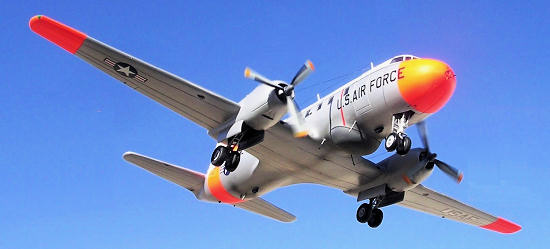 operator
students. T-29B 0-15122 falls in the second batch of T-29bs delivered
(51-5114-5172).
operator
students. T-29B 0-15122 falls in the second batch of T-29bs delivered
(51-5114-5172).
The
method of building the T-29 is the same as with any vac form kit. Mainly
consists of scoring around the bare edges of all moulded parts and break away
from carrier sheet. Contact edges are then sanded on all mating parts to achieve
correct width and even surfaces for assembly. The fuselage halves then had the
correct number of square windows drawn using a tracing paper and fixed reference
lines drawn in pencil. Each window was drilled and shaped with rectangular
smooth files and then checked against cabin windows template. At this stage the
entire essential panel lines, entry door and compartment doors and cargo hatches
doors outlines were marked with a scribing tool (a blunt blade), nose wheel
wells marked. The same went for the main wings and tail planes, fin and rudders.
The
cockpit office and wheel compartment were then detailed. First add forward and
cabin bulkhead, floor and to these adding seating arrangement for a pilot,
co-pilot, and the observer’s seat. Control wheels, crew cabin lockers, radio and
electronic equipment compartment, instruments coaming, side and central consoles
were all added at their respective place. Crew figures were also added inside
the cabin. All these items were fixed to one half of fuselage section. Lead
weight was encased in a forward nose compartment. Intermittent plastic tabs were
then added to both halves of fuselage. Astrodomes positions were then marked
along the length of the roof. These were drilled through and shaped using a
smooth round file. Rings of plastic made from same acetate backing sheet was
made to all four virtual dome positions and only the rear three were in fact
used for the astrodomes while the forward one had sextant detail added within
the ring instead. The three astrodomes and instrument detail were added at a
later stage when the fuselage halves were bonded together.
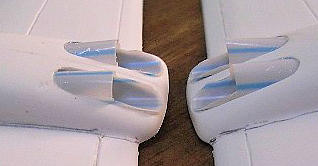 Cockpit
interior was painted in greys and touches of black on instruments and central
console. Central fuselage had two fuselage stab bars added. These were of ‘Vee’
shape and fixed across and will house and secure the dihedral wing positions.
All four bulkheads were then secured in place to give strength to the fuselage
and the fuselage halves glued together. A wooden radome was carved
from scale plans that I prepared. Wheel wells were cut and detail added to the
inside. Wheel well roofs were also added from rectangular piece of plastic and
these were to secure the wheel oleos when fixed in place. Tail plane that also
had integral part of the lower fuselage was cut, matched, merged and fixed in
place. Engine exhausts area at trailing edge of wings close to roots had two
oblong openings cut, repeating sequence to both wings. In
Cockpit
interior was painted in greys and touches of black on instruments and central
console. Central fuselage had two fuselage stab bars added. These were of ‘Vee’
shape and fixed across and will house and secure the dihedral wing positions.
All four bulkheads were then secured in place to give strength to the fuselage
and the fuselage halves glued together. A wooden radome was carved
from scale plans that I prepared. Wheel wells were cut and detail added to the
inside. Wheel well roofs were also added from rectangular piece of plastic and
these were to secure the wheel oleos when fixed in place. Tail plane that also
had integral part of the lower fuselage was cut, matched, merged and fixed in
place. Engine exhausts area at trailing edge of wings close to roots had two
oblong openings cut, repeating sequence to both wings. In
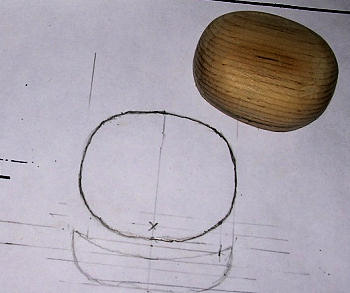 each
were fitted exhaust tubes shaped out of plastic ‘sipping straws’ that matched
the outlet diameter. Each of these was ½ inches long. The engine cowlings were
cut and the front carefully shaped open using a sharp pointed blade and a half
round file. The halve cowlings glued together and a pre painted resin Pratt and
Whitney R-2800 radial fitted at the forward end.. The cowling also had
inspection light added and engine accessories air exit, oil cooling air exit and
oil cooling air intake curved or shaped accordingly. Both wings had the landing
lights openings drilled and shaped by filing. Slot fitting the wing spar in
between the fuselage strut spars was an easier task than I have thought. This
gave the correct wing dihedral angle that was checked with a cardboard jig I
prepared.
each
were fitted exhaust tubes shaped out of plastic ‘sipping straws’ that matched
the outlet diameter. Each of these was ½ inches long. The engine cowlings were
cut and the front carefully shaped open using a sharp pointed blade and a half
round file. The halve cowlings glued together and a pre painted resin Pratt and
Whitney R-2800 radial fitted at the forward end.. The cowling also had
inspection light added and engine accessories air exit, oil cooling air exit and
oil cooling air intake curved or shaped accordingly. Both wings had the landing
lights openings drilled and shaped by filing. Slot fitting the wing spar in
between the fuselage strut spars was an easier task than I have thought. This
gave the correct wing dihedral angle that was checked with a cardboard jig I
prepared.
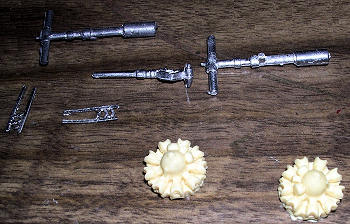 Metal
landing gear parts were cleaned from fins and more detail added to the oleo legs
and wheel well doors. The correct landing gear height checked to ensure exact
height of fuselage to ground level when the T-29 is parked. With the fuselage
set firm, exterior details as aerials, antennae, small fairings on fuselage,
pitot static tubes at nose area, rain gutter over entry door at starboard side,
door hinges, elevator and ailerons actuators, taxi lights to nose wheel etc were
all detail that was added at this stage. Three bladed metal props were sanded
smooth and the outside diameter of propeller reduced by 3 mm, which means
removing 1.5 mm from each blade tip by filing and reshaping. Thermal de-icing
air exit were engraved in form of short length louvers at tail end areas. Areas
at wing roots, tail to fuselage joining line and radome root area were all
treated with a small amount of Revell Plasto filler followed by fine wet and dry
sanding. During fine sanding operation the fuselage side windows were blanked
with masking tape to prevent any fine particles lodging inside which will come
up after Kristal Kleer is added. In the end the three astrodomes were added to
the roof. These were fixed with a small amount of Kristal Kleer on top of three
shallow rings added previously and were masked in white glue.
Metal
landing gear parts were cleaned from fins and more detail added to the oleo legs
and wheel well doors. The correct landing gear height checked to ensure exact
height of fuselage to ground level when the T-29 is parked. With the fuselage
set firm, exterior details as aerials, antennae, small fairings on fuselage,
pitot static tubes at nose area, rain gutter over entry door at starboard side,
door hinges, elevator and ailerons actuators, taxi lights to nose wheel etc were
all detail that was added at this stage. Three bladed metal props were sanded
smooth and the outside diameter of propeller reduced by 3 mm, which means
removing 1.5 mm from each blade tip by filing and reshaping. Thermal de-icing
air exit were engraved in form of short length louvers at tail end areas. Areas
at wing roots, tail to fuselage joining line and radome root area were all
treated with a small amount of Revell Plasto filler followed by fine wet and dry
sanding. During fine sanding operation the fuselage side windows were blanked
with masking tape to prevent any fine particles lodging inside which will come
up after Kristal Kleer is added. In the end the three astrodomes were added to
the roof. These were fixed with a small amount of Kristal Kleer on top of three
shallow rings added previously and were masked in white glue.
| COLORS & MARKINGS |
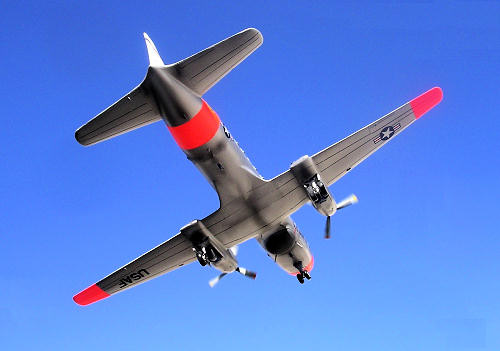
| CONCLUSIONS |
| REFERENCES |
1) T-29 Flying Classroom. Naval fighters No14.
2)
Military aircraft of the world by John Taylor and Gordon Swanborough
December 2011 If you would like your product reviewed fairly and fairly quickly, please contact the editor or see other details in the
Note to
Contributors.